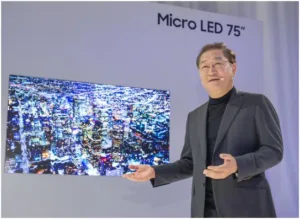Samsung Display Corporation (SDC) and LG Display (LGD) dominate the market for AMOLED displays. LGD has 100% of the market for TV-sized AMOLED panels, and SDC had almost 90% of the market for mobile AMOLED displays in 2019, with BOE & LGD taking most of the rest.. With OLED TV sales projected to grow vigorously, and with LCD margins slim (in a good year), it’s not surprising that LGD wants to expand its production.

That expansion hinges on building a new plant. As reported in Display Daily, the opening of LGD’s Gen 8.5 AMOLED plant in Guangzhou (China) has been repeatedly delayed by regulatory and technical problems. But late in July LGD announced “the beginning of mass-production in earnest.” Guangzhou will add 60,000 sheets per month to the 70,000 sheets per month currently produced at the Gen 8.5 plant in Paju (South Korea).
“Large-size OLED business is the essential growth engine of LG Display for the future,” said LGD CEO James Hoyoung Jeong, CEO of LG Display at the July 23rd opening ceremony. “[The increased production] will enable more rapid adoption of OLED displays in the market,” he said. “As the OLED market leader, LG Display will…develop differentiated products, thereby widening the technological gap between the company and the other following players in the industry.” Following players? Oh. That’s SDC.
“[The Guangzhou plant] will focus on manufacturing large-size, high-resolution OLED products including 48-inch, 55-inch, 65-inch, and 77-inch panels,” said a company press release. If justified by demand, production capacity can be expanded to 90,000 sheets per month.
Nineteen brands now manufacture OLED TVs, and the number is increasing. Market research company Omdia says 4.4 million OLED TVs will be sold this year, and predicts 12 million sets will be sold in 2025.
With those numbers in mind, it’s no wonder that SDC wants a piece of the AMOLED business. Its initial weapon of choice is QD-OLED, which uses blue OLED layers to produce the light and quantum-dot color converters to change some of the blue to red and green. SDC is investing $11 billion to develop the technology and ramp up production, and is abandoning LCD production to Chinese manufacturers.
With all this in mind you would think Samsung Visual — the Samsung company that produces TV sets — would be knocking on SDC’s door to be first in line for its share of the panels. You would be wrong. As reported last week by Barry Young in his Display Dailey, Samsung Visual has invested a lot of money in marketing its QLED and µLED TVs, and has identified itself (painted itself into a corner?) as the anti-OLED company.
Han Jong-hee, president of Samsung Electronics’s video display business, introduces a new 75-inch micro LED TV during “Samsung First Look 2019” at the Aria Hotel in Las Vegas on Jan. 6. (Caption and photo: Business Korea, Jan. 8, 2019)
What About MicroLED TV?
Wait, you say. µLED TV? Yes, sort of. At press-only events during the last two CES shows, Samsung Visual showed a very impressing 75-inch µLED TV demo, and implied that it was close to commercial introduction. That was never true. You can make a TV-sized µLED screen if you want to, but at the current stage of development it is takes much too long to make and is very, very expensive. At CES 2020, I separated a Samsung engineer from his PR minder and asked when a µLED set might appear. He said the official answer was perhaps two years, and then gave the sort of shrug and grin that clearly said, “And if you believe that there’s a nice bridge in Incheon I can sell you.”
The battle between Samsung Visual and SDC has gotten ugly, and there’s a good chance there won’t be a Samsung QD-OLED set any time soon. But there will be QD-OLED TV sets. In the past few days industry sources have told me that at least two set-makers are evaluating the panels and are committed to introducing sets in 2021. (KW)
Ken Werner is Principal of Nutmeg Consultants, specializing in the display industry, manufacturing, technology, and applications, including mobile devices, automotive, and television. He consults for attorneys, investment analysts, and companies re-positioning themselves within the display industry or using displays in their products. He is the 2017 recipient of the Society for Information Display’s Lewis and Beatrice Winner Award. You can reach him at [email protected] or www.nutmegconsultants.com.

